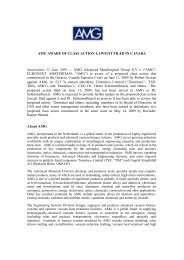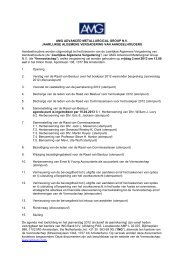C Si Ni Cr V Ti Ta Sc Li Sr Zr Fe Cu Zn Sn B Al Ce U Mn Mo Nb Sb
C Si Ni Cr V Ti Ta Sc Li Sr Zr Fe Cu Zn Sn B Al Ce U Mn Mo Nb Sb
C Si Ni Cr V Ti Ta Sc Li Sr Zr Fe Cu Zn Sn B Al Ce U Mn Mo Nb Sb
Create successful ePaper yourself
Turn your PDF publications into a flip-book with our unique Google optimized e-Paper software.
The carrying amount of deferred tax assets is reviewed at<br />
each reporting date and adjusted to the extent that it has<br />
become probable or is no longer probable that sufficient<br />
taxable profit will be available to allow all or part of the<br />
deferred tax asset to be utilized.<br />
Unrecognized deferred tax assets are reassessed at each<br />
reporting date and are recognized to the extent that it has<br />
become probable that future taxable profit will allow the<br />
deferred tax asset to be recovered.<br />
Deferred tax assets and liabilities are measured at the tax<br />
rates that are expected to apply to the year when the asset<br />
is realized or the liability is settled, based on tax rates<br />
(and tax laws) that have been enacted or substantively<br />
enacted at the reporting date.<br />
Deferred tax relating to items recognized outside profit<br />
or loss is recognized outside profit or loss. Deferred tax<br />
items are recognized in correlation to the underlying<br />
transaction either in other comprehensive income or<br />
directly in equity.<br />
Deferred tax assets and deferred tax liabilities are offset,<br />
if a legally enforceable right exists to set off current tax<br />
assets against current income tax liabilities and the<br />
deferred taxes relate to the same taxable entity and the<br />
same taxation authority.<br />
Sales tax<br />
Revenues, expenses and assets are recognized net of the<br />
amount of sales tax except:<br />
• where the sales tax incurred on a purchase of assets or<br />
services is not recoverable from the taxation authority,<br />
in which case the sales tax is recognized as part of the<br />
cost of acquisition of the asset or as part of the expense<br />
item as applicable; and<br />
• receivables and payables that are stated with the<br />
amount of sales tax included.<br />
The net amount of sales tax recoverable from, or payable<br />
to, the taxation authority is included as part of receivables<br />
or payables in the statement of financial position.<br />
Additional income taxes that arise from the distribution of<br />
dividends are recognized at the same time as the liability<br />
to pay the related dividend is recognized.<br />
(s) Segment reporting<br />
IFRS 8 defines an operating segment as: a component<br />
of an entity (a) that engages in business activities<br />
from which it may earn revenues and incur expenses<br />
(including revenues and expenses relating to transactions<br />
with other components of the same entity), (b) whose<br />
operating results are regularly reviewed by the entity’s<br />
chief operating decision maker to make decisions about<br />
resources to be allocated to the segment and assess<br />
its performance, and (c) for which discrete financial<br />
information is available.<br />
(t) New and amended standards<br />
The accounting policies and improvement to IFRSs<br />
adopted are consistent with those of the previous financial<br />
year except as follows:<br />
The following new standards, amendments to standards<br />
and interpretations are effective for the year ended<br />
December 31, 2010. If applicable, these standards and<br />
interpretations have been applied in preparing these<br />
consolidated financial statements:<br />
• IFRS 2 Share-based Payment: Company Cash-settled<br />
Share-based Payment Transactions clarifies the scope<br />
and accounting for company cash-settled share-based<br />
payment transactions. The Company adopted this<br />
amendment as of January 1, 2010. It did not have a<br />
material impact on the financial position or performance<br />
of the Company.<br />
• IFRS 3 Business Combinations (Revised) and IAS 27<br />
Consolidated and Separate Financial Statements<br />
(Amended) introduce significant changes in the<br />
accounting for business combinations occurring after<br />
becoming effective. Changes affect the valuation of a<br />
non-controlling interest, the accounting for transaction<br />
costs, the initial recognition and subsequent measurement<br />
of a contingent consideration and business<br />
combinations achieved in stages. These changes impact<br />
the amount of goodwill recognized, the reported results<br />
in the period that an acquisition occurs and future reported<br />
results. IAS 27 (Amended) requires that a change<br />
in the ownership interest of a subsidiary (without loss of<br />
control) is accounted for as a transaction with owners in<br />
their capacity as owners. Therefore, such transactions<br />
will no longer give rise to goodwill, nor will it give rise<br />
to a gain or loss. Furthermore, the amended standard<br />
changes the accounting for losses incurred by the<br />
subsidiary as well as the loss of control of a subsidiary.<br />
The changes by IFRS 3 (Revised) and IAS 27 (Amended)<br />
affect acquisitions or loss of control of subsidiaries<br />
and transactions with non-controlling interests after<br />
January 1, 2010. The change in accounting policy was<br />
applied prospectively and had no material impact on<br />
earnings per share.<br />
• IFRIC 17 Distributions of Non-cash Assets to Owners<br />
provides guidance on accounting for arrangements<br />
whereby an entity distributes non-cash assets to<br />
shareholders either as a distribution of reserves or as<br />
dividends. The interpretation has no effect on either the<br />
financial position or performance of the Company.<br />
Notes to Consolidated Financial Statements 89







